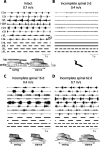Prominent role of the spinal central pattern generator in the recovery of locomotion after partial spinal cord injuries
- PMID: 18400897
- PMCID: PMC6670475
- DOI: 10.1523/JNEUROSCI.5692-07.2008
Prominent role of the spinal central pattern generator in the recovery of locomotion after partial spinal cord injuries
Abstract
The re-expression of hindlimb locomotion after complete spinal cord injuries (SCIs) is caused by the presence of a spinal central pattern generator (CPG) for locomotion. After partial SCI, however, the role of this spinal CPG in the recovery of hindlimb locomotion in the cat remains mostly unknown. In the present work, we devised a dual-lesion paradigm to determine its possible contribution after partial SCI. After a partial section of the left thoracic segment T10 or T11, cats gradually recovered voluntary quadrupedal locomotion. Then, a complete transection was performed two to three segments more caudally (T13-L1) several weeks after the first partial lesion. Cats that received intensive treadmill training after the partial lesion expressed bilateral hindlimb locomotion within hours of the complete lesion. Untrained cats however showed asymmetrical hindlimb locomotion with the limb on the side of the partial lesion walking well before the other hindlimb. Thus, the complete spinalization revealed that the spinal CPG underwent plastic changes after the partial lesions, which were shaped by locomotor training. Over time, with further treadmill training, the asymmetry disappeared and a bilateral locomotion was reinstated. Therefore, although remnant intact descending pathways must contribute to voluntary goal-oriented locomotion after partial SCI, the recovery and re-expression of the hindlimb locomotor pattern mostly results from intrinsic changes below the lesion in the CPG and afferent inputs.
Figures









Similar articles
-
A dual spinal cord lesion paradigm to study spinal locomotor plasticity in the cat.Ann N Y Acad Sci. 2013 Mar;1279:127-34. doi: 10.1111/j.1749-6632.2012.06823.x. Ann N Y Acad Sci. 2013. PMID: 23531010 Review.
-
Recovery of locomotion in cats after severe contusion of the low thoracic spinal cord.J Neurophysiol. 2020 Apr 1;123(4):1504-1525. doi: 10.1152/jn.00498.2019. Epub 2020 Feb 26. J Neurophysiol. 2020. PMID: 32101502
-
Recovery of hindlimb locomotion after incomplete spinal cord injury in the cat involves spontaneous compensatory changes within the spinal locomotor circuitry.J Neurophysiol. 2011 Oct;106(4):1969-84. doi: 10.1152/jn.00368.2011. Epub 2011 Jul 20. J Neurophysiol. 2011. PMID: 21775717
-
The "beneficial" effects of locomotor training after various types of spinal lesions in cats and rats.Prog Brain Res. 2015;218:173-98. doi: 10.1016/bs.pbr.2014.12.009. Epub 2015 Mar 29. Prog Brain Res. 2015. PMID: 25890137 Review.
-
Plastic Changes in Lumbar Locomotor Networks after a Partial Spinal Cord Injury in Cats.J Neurosci. 2015 Jun 24;35(25):9446-55. doi: 10.1523/JNEUROSCI.4502-14.2015. J Neurosci. 2015. PMID: 26109667 Free PMC article.
Cited by
-
Single cell atlas of spinal cord injury in mice reveals a pro-regenerative signature in spinocerebellar neurons.Nat Commun. 2022 Sep 26;13(1):5628. doi: 10.1038/s41467-022-33184-1. Nat Commun. 2022. PMID: 36163250 Free PMC article.
-
How Does the Central Nervous System for Posture and Locomotion Cope With Damage-Induced Neural Asymmetry?Front Syst Neurosci. 2022 Mar 3;16:828532. doi: 10.3389/fnsys.2022.828532. eCollection 2022. Front Syst Neurosci. 2022. PMID: 35308565 Free PMC article. Review.
-
A Controlled Clinical Study of Intensive Neurorehabilitation in Post-Surgical Dogs with Severe Acute Intervertebral Disc Extrusion.Animals (Basel). 2021 Oct 22;11(11):3034. doi: 10.3390/ani11113034. Animals (Basel). 2021. PMID: 34827767 Free PMC article.
-
Ladder Treadmill: A Method to Assess Locomotion in Cats with an Intact or Lesioned Spinal Cord.J Neurosci. 2017 May 31;37(22):5429-5446. doi: 10.1523/JNEUROSCI.0038-17.2017. Epub 2017 May 4. J Neurosci. 2017. PMID: 28473641 Free PMC article.
-
Generation of Locomotor-Like Activity in the Isolated Rat Spinal Cord Using Intraspinal Electrical Microstimulation Driven by a Digital Neuromorphic CPG.Front Neurosci. 2016 Mar 7;10:67. doi: 10.3389/fnins.2016.00067. eCollection 2016. Front Neurosci. 2016. PMID: 27013936 Free PMC article.
References
-
- Ballermann M, Fouad K. Spontaneous locomotor recovery in spinal cord injured rats is accompanied by anatomical plasticity of reticulospinal fibers. Eur J Neurosci. 2006;23:1988–1996. - PubMed
-
- Barbeau H, Rossignol S. Recovery of locomotion after chronic spinalization in the adult cat. Brain Res. 1987;412:84–95. - PubMed
-
- Barbeau H, Rossignol S. Enhancement of locomotor recovery following spinal cord injury. Curr Opin Neurol. 1994;7:517–524. - PubMed
-
- Barbeau H, Visintin M. Optimal outcomes obtained with body-weight support combined with treadmill training in stroke subjects. Arch Phys Med Rehabil. 2003;84:1458–1465. - PubMed
-
- Bareyre FM, Kerschensteiner M, Raineteau O, Mettenleiter TC, Weinmann O, Schwab ME. The injured spinal cord spontaneously forms a new intraspinal circuit in adult rats. Nat Neurosci. 2004;7:269–277. - PubMed
Publication types
MeSH terms
LinkOut - more resources
Full Text Sources
Medical
Research Materials
Miscellaneous
